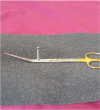Randomized trial comparing episiotomies with Braun-Stadler episiotomy scissors and EPISCISSORS-60(®)
- PMID: 26082666
- PMCID: PMC4459625
- DOI: 10.2147/MDER.S83360
Randomized trial comparing episiotomies with Braun-Stadler episiotomy scissors and EPISCISSORS-60(®)
Abstract
Introduction: Episiotomy angle is a crucial factor in causation of obstetric anal sphincter injuries (OASIS), which are the major cause of female bowel incontinence. Sutured episiotomies angled too close to the midline (<30 degree) or too far away from the midline (>60 degree) fail to unload the perineum sufficiently and predispose to OASIS. A 25-degree post-delivery episiotomy suture angle has a 10% risk of OASIS while 45-degree episiotomy is associated with 0.5% risk. To account for perineal distension at crowning, a 60-degree episiotomy incision is required to achieve 43-50 degree suture angles. We compared episiotomy suture angles with commonly used Braun-Stadler episiotomy scissors with the new fixed angle EPISCISSORS-60(®).
Methods: Ethical approval was obtained. A prospective cluster randomization design was chosen. Thirty-one patients were required in each group for a 12-degree difference with power at 90% and 5% significance. Sutured episiotomy angles and post-delivery linear distance from caudal end of the sutured episiotomy to the anus were measured with protractors and rulers. Two-tailed t-tests were used to compare the two groups.
Results: Thirty-one nulliparae had episiotomies with EPISCISSORS-60(®), 32 with Braun-Stadler. Mean age (25 versus 24.8 years) was similar. EPISCISSORS-60(®) episiotomies were angled 12 degrees more laterally away from the anus compared to Braun-Stadler (40.6 degrees, 95% confidence interval [CI] ±2, interquartile range [IQR] 35-45 versus 28.3 degrees, 95% CI ±2, IQR 25-30, P<0.0001). The post-delivery linear distance from caudal end of the sutured episiotomy to the anus was 15 mm more with the EPISCISSORS-60(®) compared to Braun-Stadler (35 mm, 95% CI ±2.2, IQR =30-39 versus 19.5; 95% CI ±1.3, IQR =14.75-22.25 P<0.0001). EPISCISSORS-60(®) episiotomies measured longer (47 mm versus 40 mm, P<0.0001). There were no OASIS cases in the EPISCISSORS-60(®) group versus one in the Braun-Stadler group.
Conclusion: The EPISCISSORS-60(®) sutured episiotomies are much further away from the midline in angular and distance measures, hence at lower OASIS risk.
Keywords: EPISCISSORS-60®; episiotomy; obstetric anal sphincter injuries (OASIS); perineal tears.
Figures
References
-
- Tincello DG, Williams A, Fowler GE, Adams EJ, Richmond DH, Alfirevic Z. Differences in episiotomy technique between midwives and doctors. BJOG. 2003;110(12):1041–1044. - PubMed
-
- Eogan M, Daly L, O’Connell PR, O’Herlihy C. Does the angle of episiotomy affect the incidence of anal sphincter injury? BJOG. 2006;113(2):190–194. - PubMed
-
- Kalis V, Landsmanova J, Bednarova B, Karbanova J, Laine K, Rokyta Z. Evaluation of the incision angle of mediolateral episiotomy at 60 degrees. Int J Gynecol Obstet. 2011;112(3):220–224. - PubMed
LinkOut - more resources
Full Text Sources




